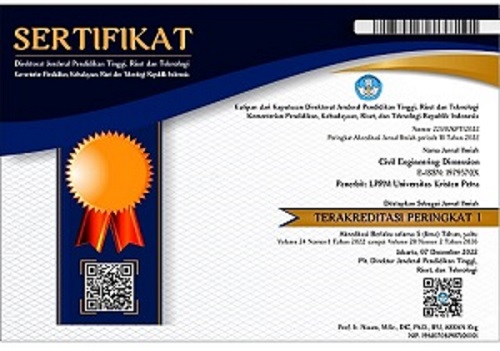Prediction of Crack Width Due to Corrosion of PC Tendon in Prestressed Concrete Structures
 :
:
https://doi.org/10.9744/ced.17.2.67-75
Keywords:
Corrosion expansion, corrosive product, elastic expansion, numerical simulation, PC tendon.Abstract
Corrosion expansion of prestressed concrete (PC) tendon affects mainly crack width on surface of concrete. This paper simulates corrosion expansion of PC tendon in concrete. Elastic expansion model is utilized for growing of corrosive product as a result of oxidation reaction on reinforcement. In reality, corrosive product penetrate freely into concrete. In order to cover this behavior, elastic expansion is then enhanced its capability in numerical simulation. Furthermore the proposed model used an apparent expansion is adopted to predict width of corrosion crack. Laboratory test is conducted to verify numerical result. Single and multi PC tendons embedded in concrete attacked by corrosion is investigated. Finally, prediction of crack width on surface of concrete due to corrosion of multi layers of PC tendons in the real pretensioned PC girder are conducted using the proposed model. The results show that corrosion crack width of the proposed model meets the real pretensionedReferences
Astutiningsih, S., Rustandi, A., and Noermalasari, D., Corrosion of Steel Reinforcements in Fly Ash and Kaolin-based Geopolymer Concrete Immersed in Distilled Water and ASTM Seawater, Civil Engineering Dimension, 15(2), 2013, pp. 89-95.
Du, Y.G., Chan, A.H.C., and Clark, L.A., Finite Element Analysis of the Effect of Radial Expansion of Corroded Reinforcement, Computer and Structures, 84, 2006, pp. 917-929.[CrossRef]
Zhao, Y., Karimi, A.R., Wong, H.S, Hu, B., Buenfield, N.R., and Jin, W., Comparison of Uniform and Non-uniform Corrosion Induced Damage in Reinforced Concrete based on a Gaussian Description of the Corrosion Layer, Corrosion Science, 53, 2011, pp. 2803-2814.[CrossRef]
Maryoto, A., Kitazono, Y., and Shimomura, T., Numerical Simulation of Corrosion Crack in Reinforced Concrete (RC) and Prestressed Concrete (PC) Member, Proceeding of JSCE, Niigata Conference – Japan, 2012, pp. 378 – 381.
Zhao, Y., Ren, H., Dai H., and Jin, W., Composition and Expansion Coefficient of Rust based on X-ray Diffraction and Thermal Analysis, Corrosion Science, 53, 2011, pp. 1646-1658.[CrossRef]
Andrade, C., Tavares, F., Toro, L., and Fullea, J., Observation on the Morphology of Oxide Formation due to Reinforcement Corrosion, RILEM, 2011, pp. 179-193.[CrossRef]
Thoft, P.C., Stochastic Modeling of the Crack Initiation Time for Reinforced Concrete Structures, Structures Congress, Philadelphia, 2000.
Diana, User’s Manual, Release 9.4.4, TNO DIANA, BV, Delft, The Netherlands, 2010.
Reinhardt, H.W., Fracture Mechanics of an Elastic Softening Material like Concrete, Heron 29(2), 1984.
Comite Euro-International du Beton–Federation Internationale de la Precontrinte, CEB-FIP Model Code, Thomas Telford Ltd, London, 1990.
Downloads
Published
How to Cite
Issue
Section
License
Authors who publish with this journal agree to the following terms:- Authors retain the copyright and publishing right, and grant the journal right of first publication with the work simultaneously licensed under a Creative Commons Attribution License that allows others to share the work with an acknowledgement of the work's authorship and initial publication in this journal.
- Authors are able to enter into separate, additional contractual arrangements for the non-exclusive distribution of the journal's published version of the work (e.g., post it to an institutional repository or publish it in a book), with an acknowledgement of its initial publication in this journal.
- Authors are permitted and encouraged to post their work online (e.g., in institutional repositories or on their website) followingthe publication of the article, as it can lead to productive exchanges, as well as earlier and greater citation of published work (See The Effect of Open Access).
















